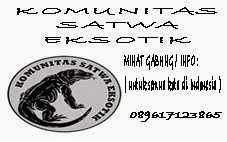sekilas tentang-iguana roatan ekor berduri-roatan spiny tailed iguana-de queiroz spiny tailed iguana-wishy willy-garrobo-ctenosaura oedirhina-T-REC Semarang-komunitas-reptil-semarang-CITES-convention-on-international-trade-in-endangered-species-of-wild-fauna-and-flora-valid from 12 june 2013-appendix 2
Ctenosaura oedirhina
- CITES…………valid from 12June 2013
- CLASS REPTILIA ( REPTILES )
-
FAMILY : iguanidae
- ctenosaura oedirhina
- Appendix : 2
- Note :sumber berbahasa asing , dengan link :
Ctenosaura
oedirhina
From
Wikipedia, the free encyclopedia
Ctenosaura oedirhina,
umumnya dikenal sebagai iguana Roatán ekor berduri
/ Roatán
spiny-tailed iguana atau de
Queiroz Spiny-tailed
Iguana, adalah spesies kadal dalam keluarga Iguanidae.
endemik Honduras dan pulau Roatán, salah
satu yang mengacu dari nama-nama umum .
Habitat alamnya adalah hutan kering subtropis atau tropis.
Status konservasi
terancam oleh hilangnya habitat.
Ctenosaura oedirhina
taksonomi
Nama Ilmiah: Ctenosaura oedirhina
Otoritas Spesies: de Queiroz, 1987
Nama Umum / s:
English : iguana Roatán ekor berduri , Roatán Spiny-tailed Iguana , Wishywilly, De Queiroz Spiny-tailed Iguana
Spanyol : Garrobo
Informasi Assessment
Kategori Daftar Merah & Kriteria : Langka
Tahun Diterbitkan: 2010
Tanggal Dinilai: 2010-02-05
Kategori Daftar Merah & Kriteria : Langka
Tahun Diterbitkan: 2010
Tanggal Dinilai: 2010-02-05
Rentang Geografis
justifikasi:
ditemukan di daerah kurang dari 5.000 km ² dan populasi yang sangat terfragmentasi, berada pada 5-10 sub-populasi yang terisolasi. Iguana ini terus menurun karena hilangnya habitat yang sedang berlangsung dan tekanan perburuan, dan karena itu terdaftar sebagai terancam punah.
Rentang Description:
dibatasi pada Isla Roatán dan Isla Barbaretta, Honduras. Iguana ini juga telah dicatat di Big Pigeon Cay, sebuah pulau dari Roatán (McCranie et al. 2005), tapi ini tidak dikonfirmasi pada survei baru-baru ini (S. Pasachnik pers. Obs. 2010). Demikian pula, laporan iguana ini ada pada Morat, sebuah pulau kecil antara Roatán dan Barbaretta, tidak dikonfirmasi pada tahun 2006 (S. Pasachnik pers. Obs.). Ada sub-populasi kecil iguana ini pada beberapa gundukan kecil di sekitar Roatán Namun, nama-nama gundukan ini sering tidak konsisten, yang lebih lanjut menghambat survei sistematis (S. Pasachnik pers. Obs. 2010). Hal ini dicatat mulai dari permukaan laut sampai 100 m.
dibatasi pada Isla Roatán dan Isla Barbaretta, Honduras. Iguana ini juga telah dicatat di Big Pigeon Cay, sebuah pulau dari Roatán (McCranie et al. 2005), tapi ini tidak dikonfirmasi pada survei baru-baru ini (S. Pasachnik pers. Obs. 2010). Demikian pula, laporan iguana ini ada pada Morat, sebuah pulau kecil antara Roatán dan Barbaretta, tidak dikonfirmasi pada tahun 2006 (S. Pasachnik pers. Obs.). Ada sub-populasi kecil iguana ini pada beberapa gundukan kecil di sekitar Roatán Namun, nama-nama gundukan ini sering tidak konsisten, yang lebih lanjut menghambat survei sistematis (S. Pasachnik pers. Obs. 2010). Hal ini dicatat mulai dari permukaan laut sampai 100 m.
negara:
asli:
Honduras
populasi
Ukuran total populasi tidak diketahui, tapi mungkin kurang dari 2.500 hewan dewasa, dibagi menjadi 5-10 sub-populasi . Keberlanjutan masing-masing subpopulasi tidak diketahui. Data genetik menunjukkan bahwa ada haplotipe yang berbeda di seluruh pulau, tapi lebih banyak data yang diperlukan untuk memahami tingkat perbedaan antara sub-populasi (S. Pasachnik pers. Comm. 2009).
Ukuran total populasi tidak diketahui, tapi mungkin kurang dari 2.500 hewan dewasa, dibagi menjadi 5-10 sub-populasi . Keberlanjutan masing-masing subpopulasi tidak diketahui. Data genetik menunjukkan bahwa ada haplotipe yang berbeda di seluruh pulau, tapi lebih banyak data yang diperlukan untuk memahami tingkat perbedaan antara sub-populasi (S. Pasachnik pers. Comm. 2009).
Habitat dan Ekologi
pada berbagai jenis habitat termasuk pantai berbatu , mangrove, dan hutan tropis kering (Holdridge 1967). adalah semi-arboreal, dan menggunakan cabang berongga dan batu sebagai perlindungan. Sedikit yang diketahui tentang ekologi iguana ini, bagaimanapun, penelitian saat ini -cara untuk memperoleh data sejarah alam bagi spesies ini.
Sistem: Terrestrial
Tindakan Konservasi
terjadi di Port Royal Wildlife Refuge, Saint Helene Wildlife Refuge, dan Barbaret Marine Reserve. Namun, tidak ada bentuk penegakan konservasi di daerah ini, sehingga iguana ini tanpa perlindungan. Ada potensi signifikan untuk beberapa daerah di Roatán dan cays kecil untuk dilindungi melalui tindakan pemilik lahan sebagai akar konservasi individu. Beberapa daerah ini telah diidentifikasi dan peneliti yang bekerja dengan banyak penduduk setempat untuk menjaga perburuan iguana ini dari properti mereka. Populasi Captive mendukung upaya konservasi yang ada di Kebun Binatang Rotterdam dan koleksi pribadi di Jerman dan Belanda. Tindakan konservasi terus menerus dilakukan oleh SA Pasachnik dan yayasan Kepulauan Bay meliputi penelitian sejarah hidup, sebuah penjangkauan dan program pendidikan dikembangkan dalam kolaborasi dengan para pendidik lokal, dan penciptaan rencana pengelolaan.
Spesies ini terdaftar di CITES Appendix II.
terjadi di Port Royal Wildlife Refuge, Saint Helene Wildlife Refuge, dan Barbaret Marine Reserve. Namun, tidak ada bentuk penegakan konservasi di daerah ini, sehingga iguana ini tanpa perlindungan. Ada potensi signifikan untuk beberapa daerah di Roatán dan cays kecil untuk dilindungi melalui tindakan pemilik lahan sebagai akar konservasi individu. Beberapa daerah ini telah diidentifikasi dan peneliti yang bekerja dengan banyak penduduk setempat untuk menjaga perburuan iguana ini dari properti mereka. Populasi Captive mendukung upaya konservasi yang ada di Kebun Binatang Rotterdam dan koleksi pribadi di Jerman dan Belanda. Tindakan konservasi terus menerus dilakukan oleh SA Pasachnik dan yayasan Kepulauan Bay meliputi penelitian sejarah hidup, sebuah penjangkauan dan program pendidikan dikembangkan dalam kolaborasi dengan para pendidik lokal, dan penciptaan rencana pengelolaan.
Spesies ini terdaftar di CITES Appendix II.
Teks Asli :
Ctenosaura oedirhina, commonly known as the Roatán
spiny-tailed iguana or de Queiroz's Spiny-tailed Iguana, is a species of lizard in the Iguanidae
family. It is endemic
to Honduras
and the island of Roatán, to which one of its common names refers.
Habitat
Its natural habitat is subtropical or tropical dry forests.Conservation status
It is threatened by habitat loss.....................
Ctenosaura oedirhina
Taxonomy
Scientific Name: Ctenosaura
oedirhina
Species Authority: de Queiroz, 1987
Common
Name/s:
English Roatán Spiny-tailed Iguana, Wishywilly, De Queiroz's
Spiny-tailed Iguana
Spanish Garrobo
Taxonomic Notes: This species
was only fairly recently described, hence it is often referenced in the
literature as Ctenosaura bakeri or Enyaliosaura bakeri, the
sister species it was split from.
Assessment Information
Red List Category & Criteria : Endangered
Year Published: 2010
Date Assessed: 2010-02-05
Geographic Range
Justification:
The Roatán Spiny-tailed Iguana is found in an area less than 5,000 km² and the population is severely fragmented, occurring in 5–10 isolated subpopulations. The iguana is continuing to decline due to ongoing habitat loss and hunting pressure, and is therefore listed as Endangered.
The Roatán Spiny-tailed Iguana is found in an area less than 5,000 km² and the population is severely fragmented, occurring in 5–10 isolated subpopulations. The iguana is continuing to decline due to ongoing habitat loss and hunting pressure, and is therefore listed as Endangered.
Range Description:
The Roatán Spiny-tailed Iguana is
restricted to Isla Roatán and Isla Barbaretta, Honduras. This iguana has also
been recorded from Big Pigeon Cay, an islet of Roatán (McCranie et al.
2005), but this was not confirmed on recent surveys (S. Pasachnik pers. obs.
2010). Similarly, reports of this iguana occurring on Morat, a small
island between Roatán and Barbaretta, were not confirmed in 2006 (S. Pasachnik
pers. obs.). There are small subpopulations of this iguana on multiple small
cays around Roatán, however, the names of these cays are often inconsistent,
further hindering systematic surveying (S. Pasachnik pers. obs. 2010). It is
recorded as occurring from sea level up to 100 m.
Countries:
Native:
Honduras (Honduran Caribbean Is.)
Population
Total population size is not known, but perhaps is less than 2,500 mature
individuals, split into 5-10 subpopulations. The sustainability of each
subpopulation is not known. Genetic data indicate that there are distinct
haplotypes throughout the island, but more data are needed in order to
understand the degree of divergence between subpopulations (S. Pasachnik pers.
comm. 2009).
Habitat and Ecology
The Roatán Spiny-tailed Iguana occurs in a variety of habitat types
including beach and rocky ocean front, mangrove, and tropical dry forest
(Holdridge 1967). It is semi-arboreal, and uses hollow branches and rocks as
retreats. Little is known about the ecology of this iguana, however, research
is currently under-way to obtain natural history data for this species.
Systems: Terrestrial
Conservation Actions
The Roatán Spiny-tailed Iguana is known to occur within Port Royal Wildlife
Refuge, Saint Helene Wildlife Refuge, and Barbaret Marine Reserve.
However, there is no form of conservation enforcement within this area,
thus this iguana is afforded no protection. There is significant potential for
some areas on Roatán and smaller cays to be protected through individual
landowner grass-roots conservation actions. Several of these areas have been
identified and researchers are working with many locals to keep hunting of this
iguana off their property. Captive populations supporting conservation efforts
exist in Rotterdam Zoo and in private collections in Germany and the
Netherlands. Ongoing conservation actions conducted by S.A. Pasachnik and the
Bay Islands Foundation include life history research, an outreach and education
program developed in collaboration with local educators, and the creation of a
management plan.
The species is listed on CITES Appendix II.
The species is listed on CITES Appendix II.















